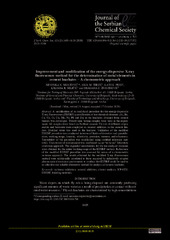Improvement and modification of energy-dispersive X-ray fluorescence method for determination of metal elements in cement leachates-chemometric approach
Чланак у часопису (Објављена верзија)
Метаподаци
Приказ свих података о документуАпстракт
A modification of analytical procedure for energy-dispersive X-ray fluorescence (EDXRF) quantification of ten chemical elements (As, Ba, Cd, Co, Cr, Cu, Mo, Ni, Pb, Zn) in the leachates obtained from cement binders was developed. Twenty-nine testing samples were used in the experiment. All samples were based on Portland cement. Fly ash of different origin, zeolite and bentonite were employed as mineral additives in the cement binders. Distilled water was used as leachate. Validation of the modified EDXRF procedure was conducted in terms of limits of detection and quantification, working range, linearity, selectivity, precision, trueness, and robustness. Traceability of the procedure was established using certified reference materials. Uncertainty of measurement was confirmed via "in-house" laboratory validation approach. The expanded uncertainties for ten analysed elements were obtained for entire working range of EDXRF method. Robustness of the modified EDXRF procedure was assessed by... means of chemometric in-house approach. The results obtained by modified X-ray fluorescence method were additionally correlated to those acquired by inductively coupled plasma optical emission spectrometry to confirm that EDXRF can be used as an effective and reliable alternative method for analysis of cement leachates.
Кључне речи:
Cluster analysis / EDXRF, building materials / Icp-oes / In-house validation / Mineral additivesИзвор:
Journal of the Serbian Chemical Society, 2020, 85, 1-15Издавач:
- Serbian Chemical Society, Belgrade
Финансирање / пројекти:
- Министарство науке, технолошког развоја и иновација Републике Србије, институционално финансирање - 200012 (Институт за испитивање материјала Србије - ИМС, Београд) (RS-MESTD-inst-2020-200012)
DOI: 10.2298/JSC200501067M
ISSN: 0352-5139
PubMed:
WoS: 000617343400007
Scopus: 2-s2.0-85096893128
Институција/група
Tehnološko-metalurški fakultetTY - JOUR AU - Mijatović, N.N. AU - Terzić, Anja AU - Pezo, Lato AU - Miličić, L.R. AU - Živojinović, Dragana PY - 2020 UR - http://TechnoRep.tmf.bg.ac.rs/handle/123456789/4570 AB - A modification of analytical procedure for energy-dispersive X-ray fluorescence (EDXRF) quantification of ten chemical elements (As, Ba, Cd, Co, Cr, Cu, Mo, Ni, Pb, Zn) in the leachates obtained from cement binders was developed. Twenty-nine testing samples were used in the experiment. All samples were based on Portland cement. Fly ash of different origin, zeolite and bentonite were employed as mineral additives in the cement binders. Distilled water was used as leachate. Validation of the modified EDXRF procedure was conducted in terms of limits of detection and quantification, working range, linearity, selectivity, precision, trueness, and robustness. Traceability of the procedure was established using certified reference materials. Uncertainty of measurement was confirmed via "in-house" laboratory validation approach. The expanded uncertainties for ten analysed elements were obtained for entire working range of EDXRF method. Robustness of the modified EDXRF procedure was assessed by means of chemometric in-house approach. The results obtained by modified X-ray fluorescence method were additionally correlated to those acquired by inductively coupled plasma optical emission spectrometry to confirm that EDXRF can be used as an effective and reliable alternative method for analysis of cement leachates. PB - Serbian Chemical Society, Belgrade T2 - Journal of the Serbian Chemical Society T1 - Improvement and modification of energy-dispersive X-ray fluorescence method for determination of metal elements in cement leachates-chemometric approach EP - 15 SP - 1 VL - 85 DO - 10.2298/JSC200501067M ER -
@article{
author = "Mijatović, N.N. and Terzić, Anja and Pezo, Lato and Miličić, L.R. and Živojinović, Dragana",
year = "2020",
abstract = "A modification of analytical procedure for energy-dispersive X-ray fluorescence (EDXRF) quantification of ten chemical elements (As, Ba, Cd, Co, Cr, Cu, Mo, Ni, Pb, Zn) in the leachates obtained from cement binders was developed. Twenty-nine testing samples were used in the experiment. All samples were based on Portland cement. Fly ash of different origin, zeolite and bentonite were employed as mineral additives in the cement binders. Distilled water was used as leachate. Validation of the modified EDXRF procedure was conducted in terms of limits of detection and quantification, working range, linearity, selectivity, precision, trueness, and robustness. Traceability of the procedure was established using certified reference materials. Uncertainty of measurement was confirmed via "in-house" laboratory validation approach. The expanded uncertainties for ten analysed elements were obtained for entire working range of EDXRF method. Robustness of the modified EDXRF procedure was assessed by means of chemometric in-house approach. The results obtained by modified X-ray fluorescence method were additionally correlated to those acquired by inductively coupled plasma optical emission spectrometry to confirm that EDXRF can be used as an effective and reliable alternative method for analysis of cement leachates.",
publisher = "Serbian Chemical Society, Belgrade",
journal = "Journal of the Serbian Chemical Society",
title = "Improvement and modification of energy-dispersive X-ray fluorescence method for determination of metal elements in cement leachates-chemometric approach",
pages = "15-1",
volume = "85",
doi = "10.2298/JSC200501067M"
}
Mijatović, N.N., Terzić, A., Pezo, L., Miličić, L.R.,& Živojinović, D.. (2020). Improvement and modification of energy-dispersive X-ray fluorescence method for determination of metal elements in cement leachates-chemometric approach. in Journal of the Serbian Chemical Society Serbian Chemical Society, Belgrade., 85, 1-15. https://doi.org/10.2298/JSC200501067M
Mijatović N, Terzić A, Pezo L, Miličić L, Živojinović D. Improvement and modification of energy-dispersive X-ray fluorescence method for determination of metal elements in cement leachates-chemometric approach. in Journal of the Serbian Chemical Society. 2020;85:1-15. doi:10.2298/JSC200501067M .
Mijatović, N.N., Terzić, Anja, Pezo, Lato, Miličić, L.R., Živojinović, Dragana, "Improvement and modification of energy-dispersive X-ray fluorescence method for determination of metal elements in cement leachates-chemometric approach" in Journal of the Serbian Chemical Society, 85 (2020):1-15, https://doi.org/10.2298/JSC200501067M . .



